DIY vs Professional Home Theater Setup: Which Is Right for You?
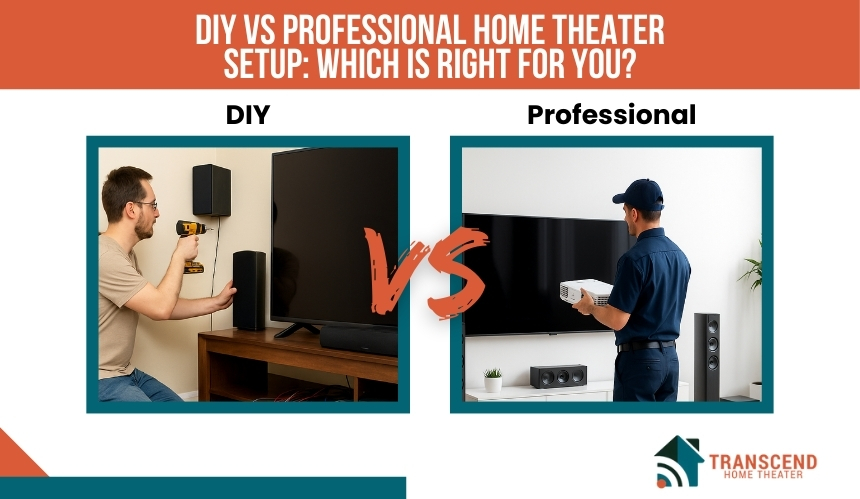
Building a home theater is one of the most rewarding ways to transform everyday entertainment into a cinematic experience. The first major decision most homeowners face is whether to install the system themselves or hire professional installers. This choice is not only about cost but also about convenience, performance, and long-term reliability.
In this guide, we will break down the advantages and disadvantages of both approaches. By the end, you will clearly understand how a DIY installation compares with professional services in technical expertise, time investment, and overall user satisfaction.
Understanding DIY Home Theater Installation
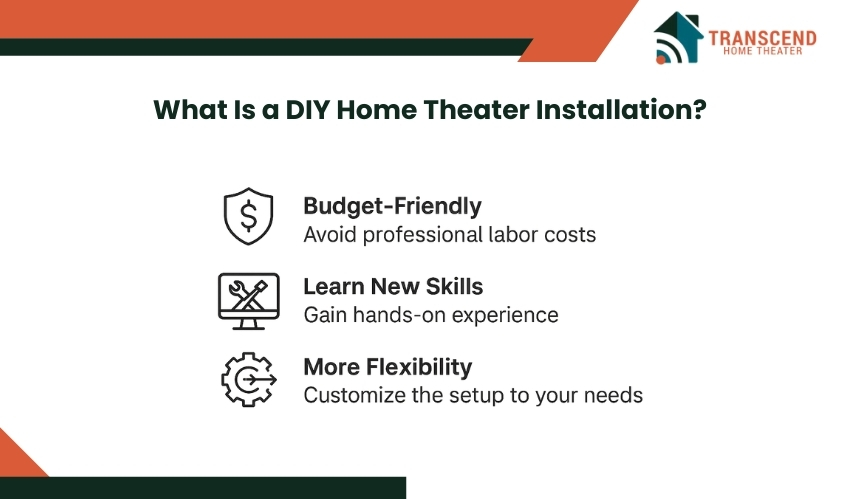
DIY home theater installation refers to setting up the entire system yourself, from planning the layout to choosing and installing equipment. This route offers full control over the design, ensuring it fits your space, style, and entertainment needs.
DIY installation is ideal for those who enjoy hands-on projects and want to customize every detail, without relying on professional assistance.
Pros of DIY Home Theater Installation
DIY home theater installation can be a deeply rewarding project, offering several benefits that attract many homeowners. While there’s effort involved, the advantages often outweigh the challenges, especially for those who enjoy tackling technology-driven tasks.
How much money can you save with DIY installation?
Skipping professional labor costs allows homeowners to allocate more of their budget toward higher-quality projectors, surround speakers, or subwoofers. The savings can be substantial, especially for those comfortable sourcing their own wiring kits, mounts, and calibration tools.
Does DIY installation help you learn new skills?
Taking on the project yourself provides hands-on experience with audio-visual wiring, acoustic planning, and smart device integration. This knowledge not only boosts confidence but also makes future upgrades easier, since you already understand the system’s setup.
Why does DIY offer more flexibility?
Doing the installation yourself ensures total control over equipment placement, decor coordination, and future modifications. You can experiment with seating positions, adjust lighting controls, and reposition speakers until the sound and visuals match your personal preference.
Cons of DIY Home Theater Installation
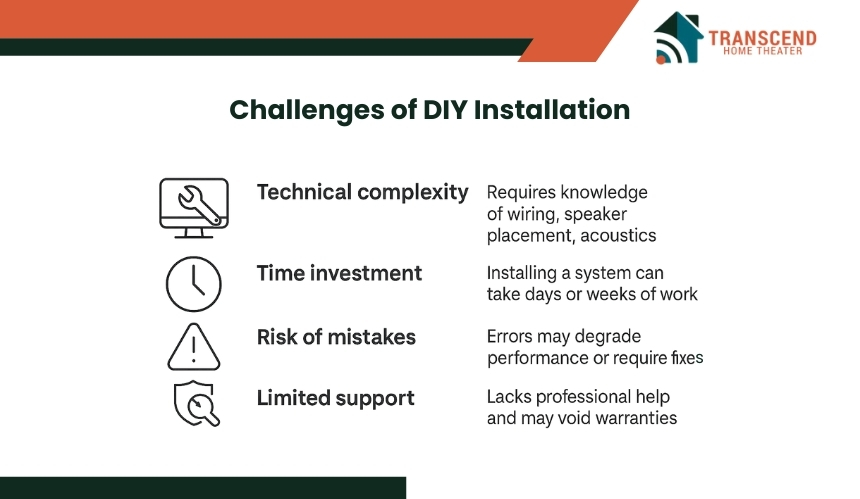
While DIY home theater installation can be rewarding, there are several potential drawbacks to consider. These challenges range from technical difficulties to time commitments and possible errors that may impact the final setup. Let’s dive into the most common disadvantages of handling the installation yourself.
What are the technical challenges of DIY installation?
DIY home theater installation can be technically demanding. Understanding wiring, speaker placement, and acoustics requires knowledge and expertise. Without proper handling, even small mistakes can significantly impact sound quality or lead to system malfunctions, which means troubleshooting can become a frustrating task.
How much time does DIY installation take?
Time is one of the biggest investments when doing a DIY home theater setup. What might take a professional a few hours can take days or even weeks for a DIYer. The time spent researching equipment, installing it, and tweaking settings may feel overwhelming, especially if you’re balancing other responsibilities.
What happens if errors occur during DIY installation?
Without the guidance of an expert, mistakes during the setup process are inevitable. Whether it’s improper wiring, poorly mounted displays, or sound calibration issues, errors can degrade your system’s performance. In some cases, you may need to call in a professional later to correct mistakes, adding unexpected costs.
Is there support and warranty for DIY installations?
A DIY setup may not come with the same level of support as a professional installation. If your equipment malfunctions, manufacturers may not honor warranties if the system wasn’t installed according to their guidelines. In some cases, this leaves you fully responsible for repairs or replacements, which could become costly.
Understanding Professional Home Theater Installation
Professional home theater installation involves hiring experts to handle every aspect of your setup, from planning and design to wiring and calibration. Specialists bring technical expertise to ensure that the system is optimized for the best possible performance.
For homeowners who prefer convenience and reliability, professional installation provides a hassle-free experience. It ensures that all components are correctly integrated, taking the guesswork out of the process.
Why Professional Home Theater Installation is Better
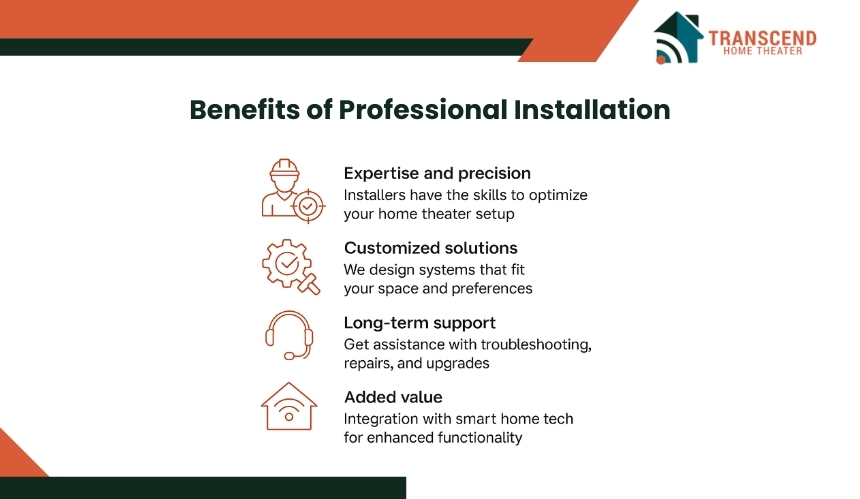
When it comes to creating the ultimate home theater experience, professional installation offers significant advantages over DIY setups. Let’s explore why opting for a professional service is often the smartest choice for homeowners who value efficiency and peace of mind.
Expertise and Precision
Professional home theater installers bring years of experience to the table. They understand the nuances of speaker calibration, wiring, and room acoustics, ensuring your system is set up for the best possible sound and picture quality.
Unlike DIY setups, which may lack precision, professionals guarantee that every component works in harmony, delivering a seamless entertainment experience.
Time and Convenience
A professional installation is typically faster and more efficient than doing it yourself. While a DIY project can take days or even weeks, experts can complete the entire setup in just a few hours.
This means you can enjoy your new home theater system sooner without sacrificing your valuable time. For busy homeowners, the convenience of having experts handle every detail is a major advantage.
Customized Solutions
Professional installers work with you to design a system tailored to your specific needs. Whether it’s optimizing the setup for a small living room or integrating advanced smart home features, professionals have the skills to customize your system to fit your space and preferences. They ensure that your home theater integrates seamlessly with your lifestyle.
Long-Term Support and Warranty
One of the most significant benefits of professional installation is the ongoing support you receive. Should any issues arise, your professional installer is available to assist with troubleshooting, repairs, or future upgrades.
Additionally, many professional installation services come with warranties, offering added peace of mind that your system is covered in case of any malfunctions.
Value-Added Services
Many professional installers go beyond the basics, providing additional services such as smart home integration, network setup, and optimization for streaming platforms. These value-added services ensure that your home theater system is not only high-quality but also future-proof, capable of adapting to the latest technological advancements.
Common Mistakes to Avoid in Home Theater Installation
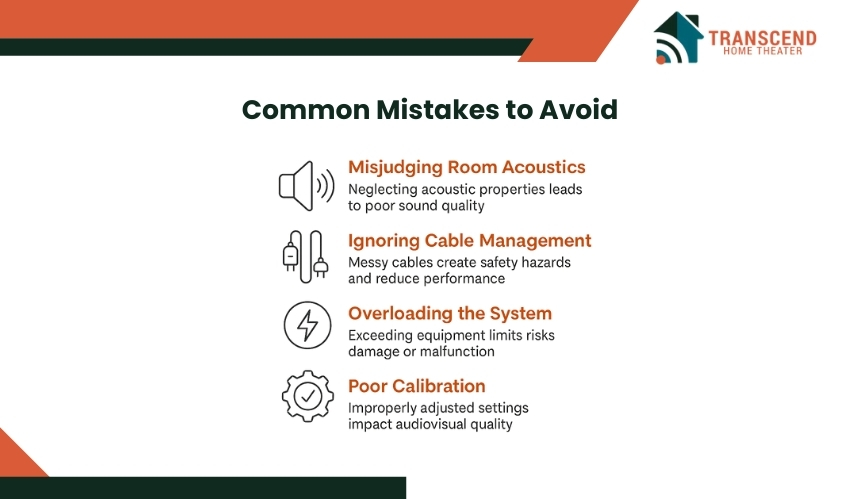
Whether you choose to install your home theater system yourself or hire professionals, it’s easy to make mistakes that can impact performance, safety, and overall satisfaction. Here’s a guide to help you avoid the most common pitfalls during the installation process.
1. Misjudging Room Acoustics
A crucial aspect of home theater setup is understanding how sound interacts with your space. DIYers often overlook acoustics, leading to poor sound quality. Incorrect speaker placement or room layout can result in audio distortion or uneven sound distribution.
2. Ignoring Cable Management
Messy wiring not only looks unsightly but can also create safety hazards and interfere with signal quality. DIYers sometimes cut corners when it comes to cable organization, leaving cables exposed or tangled. A clean, well-organized setup enhances both aesthetics and system performance.
3. Overloading the System
Trying to maximize your home theater’s capabilities can sometimes lead to overloading your equipment, particularly when it comes to power and speaker capacity. Too many high-power devices plugged into a single outlet or incompatible components can cause technical issues or even damage your system.
4. Poor Calibration
Proper calibration is essential to achieving the best picture and sound quality. DIYers may struggle with fine-tuning settings like contrast, brightness, or audio delay. Without proper calibration, your home theater may fail to deliver its full potential.
Wrapping Up: Making the Right Choice for Your Home Theater
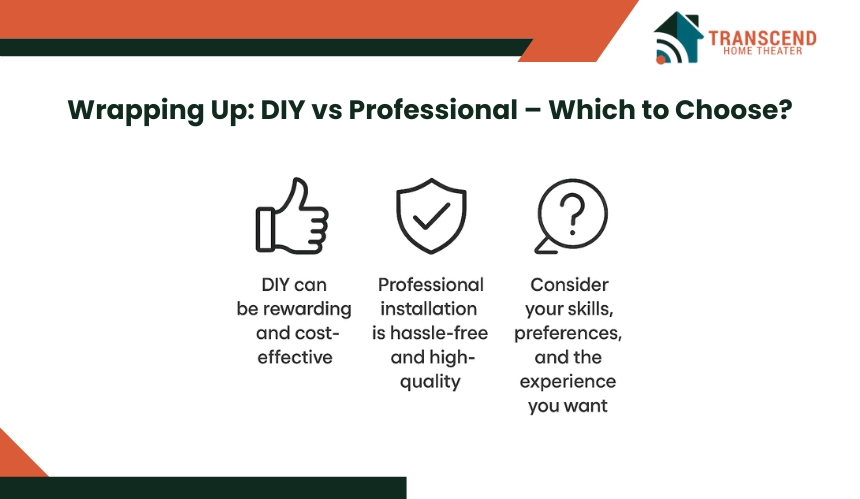
Ultimately, the decision between DIY and professional home theater installation boils down to your preferences, technical comfort level, and the experience you want.
If you’re up for the challenge, DIY can be rewarding and cost-effective. However, for a hassle-free, high-quality setup that’s built to last, professional installation is the smart choice.
At Transcend Home Theater, we specialize in designing and installing top-tier home theater systems tailored to your space and needs. Let us take the guesswork out of the equation and ensure your system delivers the ultimate entertainment experience.
Frequently Asked Questions (FAQs)
How can I integrate a soundbar into my existing home theater setup?
Integrating a soundbar into your home theater system can enhance audio quality without the complexity of a full surround sound setup. To achieve optimal performance, connect the soundbar via HDMI ARC or eARC for the best audio quality and additional features like Dolby Atmos. If HDMI ports are unavailable, a digital optical cable serves as a reliable alternative. Wireless options such as Bluetooth and Wi-Fi are also available, but wired HDMI is recommended for the best reliability and performance.
What are the benefits of using in-ceiling speakers in a home theater?
In-ceiling speakers offer a sleek, unobtrusive design while still delivering high-quality sound. They are perfect for creating an immersive audio experience without taking up floor space, which is especially beneficial for smaller rooms or minimalist designs. These speakers can blend seamlessly into the ceiling, creating a clean, modern aesthetic. Their positioning can help distribute sound more evenly throughout the room, making them a popular choice for home theater enthusiasts.
How do I optimize my home theater system for gaming?
To enhance your gaming experience, ensure your home theater system supports low latency and high refresh rates. Look for HDMI 2.1 compatibility to support 4K at 120Hz and features like Variable Refresh Rate (VRR). Additionally, consider sound systems that offer spatial audio for a more immersive experience. Proper speaker placement and room acoustics also play a crucial role in achieving optimal audio performance.
What is a 'home theater in a box', and is it a good option?
To enhance your gaming experience, ensure your home theater system supports low latency and high refresh rates. Look for HDMI 2.1 compatibility, which supports 4K at 120Hz and features like Variable Refresh Rate (VRR). A sound system that provides spatial audio can further improve the immersive experience, making you feel more connected to the game world. Proper speaker placement and room acoustics also play a key role in achieving the best audio performance.
Can I set up a home theater system outdoors?
Yes, setting up a home theater system outdoors is possible and can be a great way to enjoy movies in the open air. Outdoor home cinemas can range from temporary setups with foldable screens and portable projectors to permanent installations with weather-resistant equipment.
